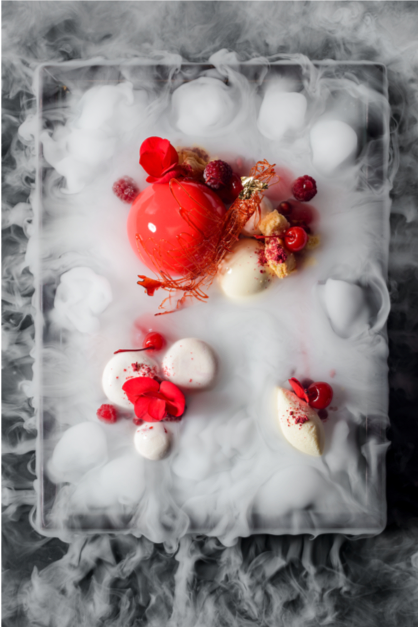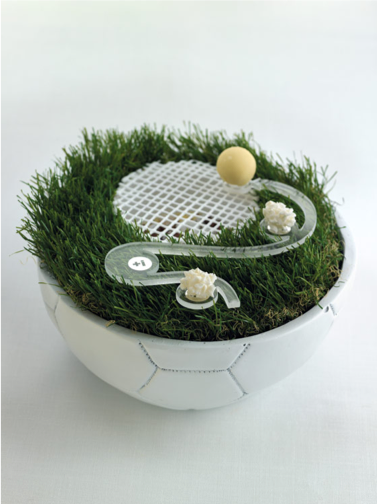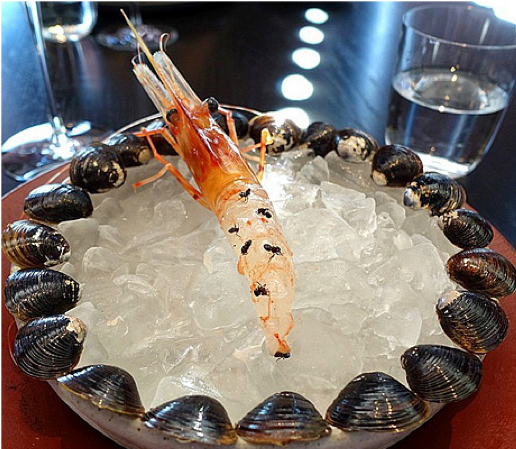Molecular Gastronomy at the World’s Best Restaurants
This week we are featuring work from students in Val Ryan’s class The Science of Food and Cooking (MET ML619). Today’s post comes from Gastronomy student Madiyar Tyurin.
Food science and the way it affects the field of gastronomy is a relatively new movement in the world of fine-dining restaurants. For centuries, people had been practicing standard and universal cooking approaches. Experimenting with food and creating new techniques of cooking started at the end of the twentieth century. Today, those restaurants where that movement began are some of the most well known in their countries and in the world. This essay is going to analyze three restaurants, elBulli, El Celler de Can Roca, and Noma, where chefs and their cuisines are highly influential on their guests, colleagues, and the entire generation of rising cooks. The concept of molecular gastronomy together with their culinary brilliance have affected the formation and professional views of three top chefs in the world and resulted in the breakthrough and rise of their restaurants to the highest positions in the world.
Most of today’s world-known restaurants were inspired by elBulli, a Spanish restaurant of molecular cuisine where Ferran Adrià created experiments with food. He stood out of the traditional chef image and was invited to Documenta in 2007. It is a highly prestigious art event in Europe that is conducted once in five years (Domene-Danes 2013, 100-126). Adrià revolutionized food by introducing such techniques as spherification or foam making from fruit juices. Participation in the Documenta fair meant that his dishes were no longer a product of the restaurant but the manifestation of art. At that time, elBulli turned into an exposition pavilion, and guests of the restaurant were considered as participants of the fair as well. His approach might sometimes be regarded as anti-synesthetic because Adrià tried to combine incompatible things, but the chef proved uniqueness by successfully introducing techno-emotional dishes in reality. Adrià’s meals combined different culinary techniques and often aimed at invoking memories. Opazo argues that achievements at elBulli created a new level of cooking that positively influenced all other chefs in the world by forcing re-thinking and re-evaluating of their ideas and knowledge (2012, 82-89). According to Solier, such desserts as liquid nitrogen pistachios at elBulli are the result of chefs’ creativity and enlightenment (2010, 155-170). It is not about traditional cooking, but scientifically proven decisions that drive Ferran Adrià to create and influence (ibid.). However, Kaufman might criticize this approach by claiming that a guest of the restaurant was no longer an independent actor at the moment of dining, as the chef promoted their own authority by telling how to eat a certain dish (2016).

(The Love of Gardening Project)
One of the most famous restaurants in the high gastronomy industry is located in Girona, Spain and called El Celler de Can Roca. It is run by three brothers, Juan, Josep and Jordi Roca, who work as a chef, a sommelier and a pastry chef there. Girona is a part of the Catalonia region, which is well-known for its terroir nature resulting in distinctive flavors and taste (Meneguel, 2017). A combination of unique climate conditions and geographic location between sea and mountains resulted in a distinctive taste of anchovies, shrimps, bovines, lamb and duck, sausages and mushrooms (Vila, 2016). Meneguel says this region was named as the best gastronomic place in Europe in 2016 and the Roca brothers’ contribution to connecting food with surrounding landscapes and culture is indeed meaningful (2017). They focus on innovation of traditional dishes using local ingredients that carry cultural meanings with the incredibly aesthetic style of serving compared to some artistic events (ibid.). Ulloa et al. argue that the concept of nostalgia or using memories to evoke emotions and create signature dishes plays a significant role in the vision of cuisine at El Celler de Can Roca (2017, 26-38). Moreover, the restaurant members highlight the importance of sharing food and emotions with others as it definitely enhances personal experience and enjoyment, similar to how traveling together might stimulate greater excitement than experiencing the same things alone (ibid.). Some of their signature dishes include the yin-yang oyster that is based on the idea of contrast when a cold oyster is served with a hot sauce, chocolate truffles in a closed rock with a real moss inside as a tribute to forests surrounding the region, or a green salad where all ingredients, such as avocado, lime, melon, cucumber, tarragon, eucalyptus and olive oil are green (Aulet et al. 2016, 135-149). As Barcelona is the capital of Catalonia, they spent their whole childhood watching soccer games and decided to make a “Messi’s Goal” dessert to praise the best soccer player in the world playing in Barcelona.

(So Good Magazine)
Noma is another one of the most prestigious restaurants in the world, located in Copenhagen, Denmark. It is a place characterized by modern Nordic cuisine, and Rene Redzepi represents a new generation of chefs who value old traditions and creative thinking. The word Noma is derived from Nomadic and Mad that means food in Dutch. Goulding claims that the number of tourists coming to the country in search of gastronomy experiences at Noma grows significantly every year (2013). Redzepi tries to reconstruct a classic restaurant model. According to Tressider, Noma’s concept is based on making unique dishes from organic products picked at local lands that embody the history of the culture and its environment (2014, 1-17). Noma could be considered as the modern type of restaurant with its own distinctive characteristics similar to the French wine concept terroir in a way that dishes created there would not be possible to re-create once moved away from the original location (ibid.). As Trubek suggests, the terroir concept attracts millions of tourists to come to a particular place in the world to experience new foods and emotions (2009). Therefore, cuisine is strongly tied to surrounding nature, and meals are changed three times a year representing different seasons. Tressider says as globalization continues to remove borders and boundaries between countries around the world, the growth of terroir restaurants could be considered as an attempt to save local values and natural response to the international homogenization (2014, 1-17). Looking at the past of Dutch history, Redzepi found that citrus plants had not grown in Denmark, and people used to eat ants that have a citrus taste to supplement the flavor of seafood. Therefore, one of the most recognizable dishes at Noma is the live ants in mayo and traditional doughnuts with sardines. Again, as the terroir cuisine is tied to geographic boundaries, it cannot be replicated anywhere else. Therefore, at a master class by Noma in London, serving dishes were largely minimized, as, for example, ants could not be delivered safely to the UK (BBC, 2009). De la Barre and Brouder argue that guests coming to terroir restaurants get unique experience encompassing all senses by terroir (2013, 1-11). It is a mechanism embodying culture, customs and place (Tressider 2014, 1-17). People from all over the world come to Copenhagen with the specific purpose to visit Noma. As Goulding explains, this trend has been called Nomanomics, meaning that the success of one place created a large attraction to the country as a whole (2013). So at this place the bond with nature is important as cuisine manifests more than chemical principles and traditional cooking techniques. Visiting Noma reflects in the adherence to creating personal identity.

(Alexander Saffron)
This essay discussed three high-class restaurants that are elBulli, El Celler de Can Roca, and Noma. All of them are characterized by a unique approach to cooking based on experimenting with food and techniques and bringing their own new vision to the culture of eating. Chefs of these restaurants did not fear expressing themselves and their ideas on the plates. This resulted in the entire movement of the popularization of molecular gastronomy and experimental cooking in the world. Today, all top restaurants try to experiment with the food to a certain extent. One of the issues that might arise with the chefs who reached all awards is the possible lack of interest and motivation to continue expressing their beliefs in the kitchens. Therefore, it is important to develop the entire sphere of molecular gastronomy at restaurants overall as competition might lead to a new level of achievement in this industry.
Bibliography:
Aulet, Silvia, Louis Mundet, and Josep Roca. “Between Tradition and Innovation: The Case of El Celler de Can Roca.” Journal of Gastronomy and Tourism 2 (2016): 135-149
De la Barre, Suzanne, and Patrick Brouder. “Consuming stories: placing food in the Arctic tourism experience”. Journal of Heritage Tourism 8, no. 2-3 (2013): 1-11
Domene-Danes, Maria. “El Bulli: Contemporary Intersections Between Food, Science, Art and Late Capitalism.” Barcelona Research Art Creation 1, no. 1 (2013): 100-126
Goulding, Matt. “Nomanomics: How One Restaurant Is Changing Denmark’s Economy.” TIME. Roads & Kingdoms, February 14, 2013. http://world.time.com/2013/02/14/nomanomics- how-one-restaurant-is-changing-denmarks-economy/
Inside Claridge’s, 2, “Episode 2,” directed by Jane Treays, aired December 11, 2012, on BBC Two, https://www.bbc.co.uk/programmes/b01pc3gk
Kaufman, Cathy. “Etiquette, Power, and Modernist Cuisine.” Dublin Gastronomy Symposium, 2016.
Lane, Christel. “The Michelin-Starred Restaurant Sector as a Cultural Industry.” An International Journal of Multidisciplinary Research 13, no. 4 (2010): 493-519
Meneguel, Cinthia. “El Celler de Can Roca and its role in stimulating the creation and development of gastronomy tourism products.” Master’s thesis, University of Girona, 2017.
Opazo, Pilar. “Discourse as driver of innovation in contemporary haute cuisine: The case of elBulli restaurant.” International Journal of Gastronomy and Food Science 1, (2012): 82-89
Saffron, Alexander. “World’s best restaurant Noma serves live ants.” The Telegraph, March 22, 2020. https://www.telegraph.co.uk/foodanddrink/foodanddrinknews/11379809/Worlds- best-restaurant-Noma-serves-live-ants.html
Solier, Isabelle. “Liquid nitrogen pistachios: Molecular gastronomy, elBulli and foodies.” European Journal of Cultural Studies 13, no. 2 (2010): 155-170
So Good Magazine. “Messi’s goal.” March 22, 2020. https://www.sogoodmagazine.com/pastry- blog/pastry-chef-articles/jordi-roca-creativity-beyond-a-dish/attachment/gol-de-messi/
The Love of Gardening Project. “Liquid Nitrogen Pistachios: Molecular Gastronomy, elBulli and foodies.” March 22, 2020. https://www.theloveofgardeningproject.com/liquid-nitrogen- pistachios
Tressider, Richard. “Eating ants: understanding the terroir restaurants as a form of destination tourism.” Journal of Tourism and Cultural Change (2014): 1-17
Trubek, Amy. The Taste of Place. Berkley: University California Press, 2009.
Ulloa, Ana Maria, Josep Roca, and Heloise Velaseca. “From Sensory Capacities to Sensible Skills: Experimenting with El Celler de Can Roca.” Gastronomica: The Journal of Critical Food Studies 17, no. 2 (2017): 26-38
Vila, Angela. “Girona candidata a Ciutat Creativa UNESCO de la gastronomia?” Master’s thesis, University of Girona, 2016.